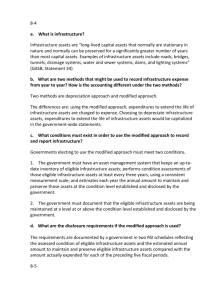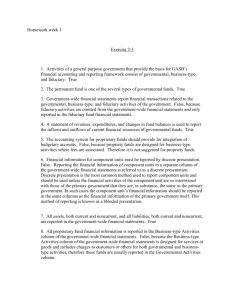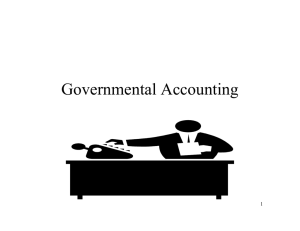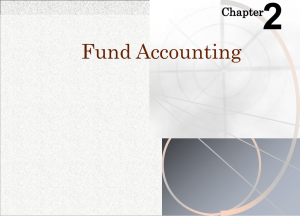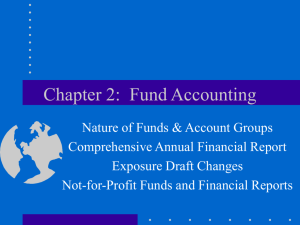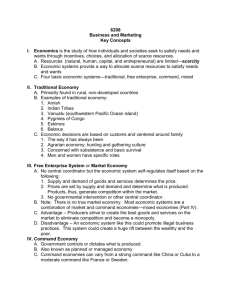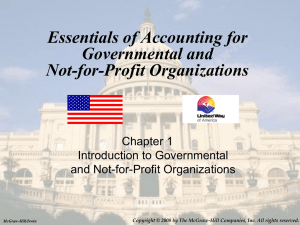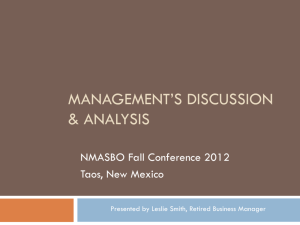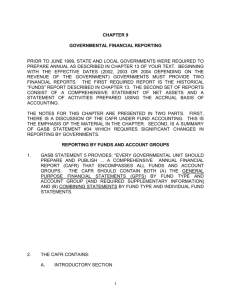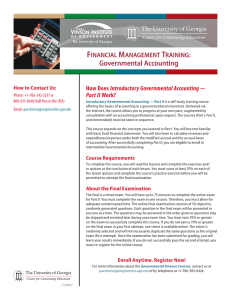State and Local Government Accounting Principles Chapter 2
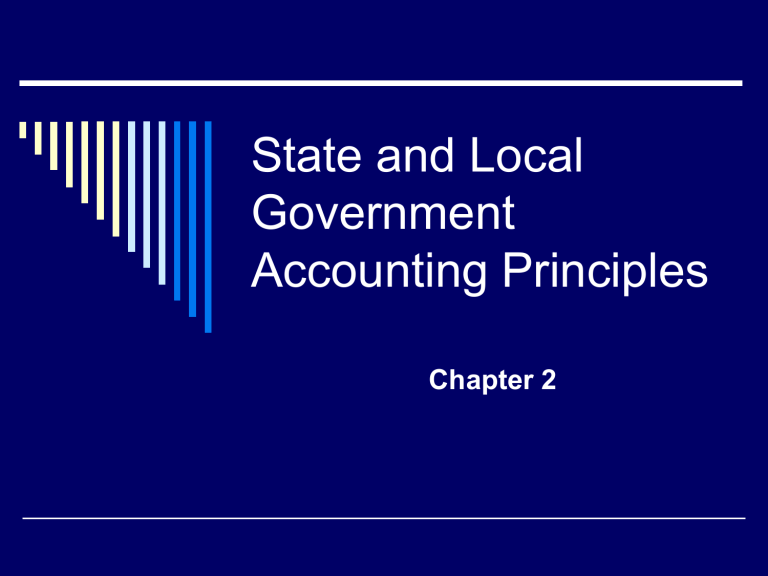
State and Local
Government
Accounting Principles
Chapter 2
Learning Objectives
Discuss major aspects of government financial reporting model
Define fund and examine broad categories
Identify MFBA found in financial statements
Analyze effects of transactions
Discuss budgetary accounting & reporting
Understand fund categories and types of funds found in each category
Understand basic financial reporting requirements
GASBS 34: Basis for
Financial Reporting
Issuance in 1999 marked a major change in governmental financial reporting
Created dual perspective reporting:
Government-wide financial statements, using accrual accounting
Fund financial statements, using other bases of accounting
Basic Financial Statements:
Overview
Fund
Financial Statements
7 - 8 Financial Statements
Governmental
Funds
Proprietary
Funds
Fiduciary
Funds
Links
[W orksheets]
Reconciliations
(Explanations)
Governmental
Activities
Government-wide
Financial Statements
2 Financial Statements
Business-Type
Activities
Total
Primary Government
Notes to the Financial Statements
Minimum Requirements for
External Financial Reporting:
The GASB’s View
Management's discussion and analysis
Government-wide financial statements
Fund financial statements
Notes to the financial statements
Required supplementary information
(other than MD&A)
Fundamentals of SLG
Accounting & Financial Reporting
1.
2.
3.
4.
5.
6.
GAAP & legal compliance
Fund accounting
Fund categories
Types of funds
Comparative financial statement formats
Annual financial reporting
GAAP & Legal Compliance
GAAP Reporting
Ensures that the financial reports of all
SLGs contain the same types of financial statements and disclosures for the same types of funds and activities
Requires “full” disclosure
GAAP & Legal Compliance
(continued)
Legal Compliance
Ranges from simple to complex requirements
May be simple if budgeting on a GAAP basis
More complex if cash or encumbrance budgeting is required
Identifying the budgetary basis is key
GAAP & Legal Compliance
(continued)
Reconciling GAAP & legal requirements
Maintain budgetary accounting control during the year
Clearly distinguish between budgetary basis from GAAP basis
Prepare statements and schedules using both bases and reconcile differences
GAAP Requirements
Trying to assure comparability among and between governments
Full disclosure may result in much more information than “adequate” disclosure required by FASB
Fund Accounting
Most distinctive feature of governmental accounting
Use of fund accounting allows for
Proper accounting controls
Demonstrating compliance
Must understand fund structure, fund model, and interrelationships between funds
Definition of a fund
Independent accounting entity with a self-balancing set of accounts
Similar to a business accounting entity
Business entity captures all reported attributes for the entire business and all its transactions
Fund captures all reported attributes of a portion of the government’s activities and resources accounted for in that fund
Fund Categories
Proprietary Funds
Governmental Funds
Nonfund accounts
Fiduciary Funds
Proprietary Funds
Similar to accounting for businesses
Accounting measures net assets, changes in net assets, and cash flows
Accounting equation:
Current Assets
+
Capital Assets
–
Current +
Long-term
Liabilities
= Net Assets
Proprietary Funds – MFBA
Measurement focus (MF)
Economic resources
Financial statement recognition of all assets and all liabilities
Basis of Accounting (BA)
Accrual
Recognize revenues when earned and expenses when incurred
Governmental Funds
Used to account for sources, uses, and balances of general government financial resources
Funds represent segregations of general government net financial assets
Accounting equation:
Financial
Assets
–
Related
Liabilities
=
Fund
Balance
Governmental Funds:
Accounting Equation Terms
Financial Assets – refers primarily to cash, investments, and receivables
Related Liabilities – related to the current year and normally paid for available current financial resources
Fund Balance – net financial assets of fund – the difference in financial assets and related liabilities
Governmental Funds – MFBA
Measurement focus – current financial resources
Basis of accounting – modified accrual
Governmental Funds:
Recognition Criteria – Revenues
Earned during or levied for the period
Objectively measurable
Collected in period or soon enough thereafter (usually 60 days) to pay liabilities incurred for expenditures of the period
Governmental Funds:
Recognition Criteria – Expenditures
When operating or capital outlay liabilities to be paid currently from governmental funds are incurred
When debt service (principal and interest) payments on long-term liabilities are due
Expenditure / Expense Comparison
Operating
Expenditures
(net financial assets expended)
Salaries, supplies, utilities, etc.
Capital Outlay Acquisition
Expenses
(cost of goods or services used)
Salaries, supplies, utilities, etc.
Depreciation
Debt Service
Principal &
Interest
Interest
Nonfund Accounts:
General Capital Assets
Capital assets used in general government activities
Not assets of any fund but of the governmental unit as a whole
Inclusion in governmental fund financial statements would increase fund balance and could mislead users
Nonfund Accounts:
General Long-term Liabilities
Secured by the general credit and revenue-raising powers of the government
Unmatured principal does not require current appropriation and expenditure of fund financial resources
If included as governmental fund liability would be misleading and dysfunctional to current period management control
Nonfund Accounts:
Accounting Equation
General Capital
Assets (GCA)
–
Unmatured General
Long-Term Liabilities
(GLTL)
=
Net Assets
(NA)
Fiduciary Funds
Accounts for assets held by government in trustee or agency capacity for others
Not used to report assets held for government’s own use
Fiduciary Funds – MFBA
Measurement focus – economic resources
Basis of accounting – accrual
Categories and Types of Funds
GOVERNMENTAL FUNDS
General Fund
Special Revenue Funds
Capital Projects Funds
Debt Service Funds
Permanent Funds
PROPRIETARY FUNDS
Enterprise Funds
Internal Service Funds
FIDUCIARY FUNDS
Pension Trust Funds
Investment Trust Funds
Agency Funds
Private Purpose Trust
Funds
Types of Proprietary Funds
Enterprise Funds – customers are usually the general public (as well as businesses and other entities besides the government’s own departments or agencies (Chapter 10)
Internal Service Funds – customers are predominantly other departments or agencies of the government (Chapter 11)
Types of Governmental Funds
General Fund – used to account for all financial resources except those required to be accounted for in another fund (Chapters 3 – 6)
Special Revenue Funds – used to account for the proceeds of specific revenue sources that are legally restricted to expenditure for specified purposes (Chapters 3 – 6)
Types of Governmental Funds
(continued)
Capital Projects Funds – used to account for financial resources that are used to acquire or construct major general capital assets or facilities.
(Chapter 7)
Debt Service Funds – used to account for the accumulation of resources for, and the payment of, general long-term debt principal and interest. (Chapter 8)
Types of Governmental Funds
(concluded)
Permanent Funds – used to account for resources that are legally restricted to the extent that only earnings, and not principal, may be used for purposes that support the reporting government’s programs
Types of Fiduciary Funds
Pension (and other employee benefit)
Trust Funds – established to account for resources that are required to be held in trust for the members and beneficiaries of defined benefit pension plans, defined contribution plans, other postemployment benefit plans, and other employee benefit plans.
Types of Fiduciary Funds
(continued)
Investment Trust Funds – used to account for the external portion of investment pools held by the sponsoring government.
Private-Purpose Trust Funds – used to account for all other trust arrangements under which principal and/or income benefit individuals or groups outside the government.
Types of Fiduciary Funds
(concluded)
Agency Funds – established to account for resources held in a purely custodial capacity for others.
All Fiduciary Funds are discussed in
Chapter 12
Interfund Transactions
Interfund loans
Interfund services provided and used
Interfund reimbursements
Interfund transfers
Of particular interest here are loans and transfers
Loans
Amounts provided by one fund to another with a requirement for repayment
Affects only balance sheet accounts
Transfers
Flows of assets from one fund to another with no requirement for repayment
Affects balance sheet and operating statement accounts
Comparative Operating Statements
Proprietary Funds
Accrual-based
Must distinguish between operating and nonoperating revenues and expenses
Separate reporting for capital contributions, special & extraordinary items, and transfers
Change in Net Assets
Governmental Funds
Modified accrual-based
Report revenues by source and expenditures by character
Other Financing Sources and Uses for other resource flows, including transfers
Special & extraordinary items reported separately
Change in Fund Balance
Comparative Balance Sheets
Proprietary Funds
Current and
Noncurrent Assets
Current and
Noncurrent Liabilities
Net Assets
Governmental Funds
Financial Assets
Related Liabilities
Fund Balance
Annual Financial Reporting
Comprehensive Annual Financial Report (CAFR)
Should be prepared for all governmental entities
Sections include:
Introductory – little GAAP for this section
Financial – most GASB standards apply to this section
Statistical – see recently issued GASBS 44
Annual Financial Reporting
C
A
F
R
MD&A
Government-
Wide
Financial Statements
Major Fund & CU
Financial Statements
Notes
Other RSI
B
F
S
Nonmajor Fund Combining Financial
Statements
Individual Fund Financial Statements
& Schedules
M
E
F
R
Transaction Data
(the accounting system)
CAFR--Comprehensive Annual Financial Report
BFS--Basic Financial Statements
MEFR--Minimum External Financial Reporting
C Copyright 2001, G. Robert Smith, Jr.
Annual Financial Reporting
Minimum reporting requirements
Management’s Discussion & Analysis
Basic Financial Statements
Government-wide financial statements
Fund financial statements
Notes to the financial statements
Required supplementary information other than MD&A
Annual Financial Reporting
Financial Reporting Entity consists of
Primary government (PG)
Organizations for which the PG is financially accountable
Other organizations whose omission would cause financial statements to be misleading or incomplete
Annual Financial Reporting
Government-wide financial statements should include separate columns for
Governmental Activities, Business-Type
Activities, Total column for PG, and discretely presented component units
Annual Financial Reporting
Management’s Discussion & Analysis
Brief discussion of financial statements
Condensed government-wide financial information
Analysis of position & results of operations
Analysis of individual funds
Budget analysis
Significant capital assets and LTL events
Modified approach
Description of currently known facts
Annual Financial Reporting
Fund Financial Statements include major funds individually and nonmajor funds in the aggregate. Fiduciary fund statements are not included in the basic financial statements.
Annual Financial Reporting
Financial Reporting Entity
Nucleus is the PG
Other activities include:
Discretely presented component units
Blended component units
Joint ventures
Jointly governed organizations
Related organizations
Annual Financial Reporting
Government-wide Financial Statements
Statement of Net Assets
Statement of Activities
Annual Financial Reporting
Governmental Fund Statements (Schedules)
Balance Sheet
Statement or Revenues, Expenditures, &
Changes in Fund Balance
Statement or Revenues, Expenditures, &
Changes in Fund Balance – Budget-to-
Actual (may be either BFS or RSI)
Annual Financial Reporting
Proprietary Fund Statements
Statement of Net Assets / Balance Sheet
Statement of Revenues, Expenses, &
Changes in Net Assets
Statement of Cash Flows
Annual Financial Reporting
Fiduciary Fund Financial Statements
Statement of Fiduciary Fund Net Assets
Statement of Changes in Fiduciary Fund
Net Assets
Transaction
Data
Preparation Process: Step 1
Start with the transaction data – the basic building blocks for everything in the Comprehensive
Annual Financial Report (CAFR),
Preparation Process: Step 2
Individual Fund
Statements
Transaction
Data
1
Schedules
From the transaction data, prepare the individual fund financial statements and schedules. Also, some of the transaction data will be used later in the CAFR preparation process.
Preparation Process: Step 3
Transaction
Data
Individual Fund
Statements
Schedules
Major Fund
Determination
2
3
1
Determine the major funds (this process will be discussed later).
Also, information from the individual fund statements and schedules will be used later in the process.
Preparation Process: Step 4
Transaction
Data
1
Individual Fund
Statements
Schedules
Non-Major Fund
Combining
Statements
Major Fund
Determination
2
3
Major Fund
Statements
Once the major funds have been determined, the non-major fund combining statements can be prepared. The total column from these statements becomes a single column in the major fund statements along with a separate column for each major fund.
Preparation Process: Step 5
Transaction
Data
Individual Fund
Statements
Schedules
Non-Major Fund
Combining
Statements
Major Fund
Determination
2
Major Fund
Statements
CU
Statements
3
Conversion
Process
Govt.-wide
Statements
1
The major funds statements undergo a conversion process and are combined with the component units financial statements to complete the government-wide statements.
Preparation Process: Step 6
Transaction
Data
Individual Fund
Statements
Schedules
Non-Major Fund
Combining
Statements
Major Fund
Determination
2
Major Fund
Statements
CU
Statements
3
3
2
Conversion
Process
Govt.-wide
Statements
Notes
1
Information from all the financial statements and the schedules are used to prepare the notes to the financial statements. This process completes the Basic Financial
Statements (BFS).
Transaction
Data
1
Preparation Process: Step 7
1
Other
RSI
Non-Major Fund
Combining
Statements
3
Individual Fund
Statements
Major Fund
Determination
Major Fund
Statements
2
Conversion
Process
Notes
2
MD&A
CU
Statements
Govt.-wide
Statements
Schedules 3
Information from the transaction data, individual fund statements, and schedules are used to complete the
Other RSI. Then information from all sources combine to provide data for the MD&A.
Budget
Personnel
Dept.
Heads
Program
Managers
